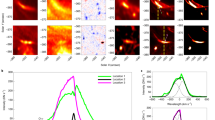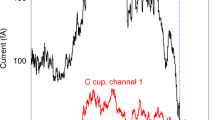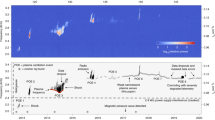Abstract
Recently, the Voyager UVS experimenters made two interesting reports on the emission morphology and energetics of the Io plasma torus. First, Sandel and Broadfoot1 provided evidence for a localized energy source in the vicinity of Io with the time-averaged power amounting to 20% of the total power radiated by the Io UV torus. Second, Shemansky and Sandel2 demonstrated that the Io torus displays a local time variation in the extreme UV (EUV) emissions with a dawn-to-dusk asymmetry differing by ∼30% and that the corresponding electron energy density available for exciting the UV emissions of the oxygen and sulphur ions varies by ∼20%. These observations provide an important insight into the mass and energy flows of the Io plasma, but call into question our understanding of the physical mechanisms that maintain the radiative emissions of the heavy ions ejected from Io. Here we discuss the physical cause of the brightening near dusk side and dimming near dawn side of the Io plasma torus EUV emissions in terms of a drift shell effect. If the radial distance of the L shell of the Io plasma torus reaches a minimum around 1800 h LT but reaches a maximum around 0600 h LT, periodic adiabatic heating and cooling of the electron gas could lead to the observed modulation of the UV irradiation. Such a drift pattern of the Io torus could be produced if the plasma convection of the jovian magnetosphere were partly determined by its planetary wind outflow.
This is a preview of subscription content, access via your institution
Access options
Subscribe to this journal
Receive 51 print issues and online access
$199.00 per year
only $3.90 per issue
Buy this article
- Purchase on Springer Link
- Instant access to full article PDF
Prices may be subject to local taxes which are calculated during checkout
Similar content being viewed by others
References
Sandel, B. R. & Broadfoot, A. L. J. geophys. Res. 87, 2231–2240 (1982).
Shemansky, D. E. & Sandel, B. R. J. geophys. Res. 87, 219–229 (1982).
Thorne, R. M. & Tsurutani, B. T. Geophys. Res. Lett. 6, 649–652 (1979).
Goertz, C. K. Geophys. Res. Lett. 7, 365–368 (1980).
Thorne, R. M. Geophys. Res. Lett. 8, 509–512 (1981).
Brown, R. A. & Ip, W.-H. Science 213, 1493–1495 (1981).
Brown, R. A. J. geophys. Res. 87, 230–234 (1982).
Goertz, C. K. & Ip, W.-H. Planet. Space Sci. 30, 855–864 (1982).
Brown, R. A. presented at Chapman Conf. Jovian Magnetosphere–Satellite Interaction Interactions, UCLA, 27–29 June (1978).
Broadfoot, A. L. et al. Science 204, 39–42 (1979).
Smith, R. A., Palmadesso, P. J. & Strobel, D. F. EOS 62, 45–99 (1981); Am. geophys. Un. Meet., Paper SM3-2-A-9 (1981).
Acuna, M. H., Neubauer, F. M. & Ness, N. F. J. geophys. Res. 86, 8513–8521 (1982).
Smith, R. A. & Goertz, C. K. J. geophys. Res. 83, 2617–2627 (1978).
Goertz, C. K. & Boswell, R. W. J. geophys. Res. 84, 7239–7246 (1979).
Thomsen, M. F., Goertz, C. K. & Van Allen, J. A. J. geophys. Res. 82, 5541–5550 (1977).
Thomsen, M. F. Rev. Geophys. Space Sci. 17, 369–387 (1979).
Ip, W.-H. J. geophys. Res. 86, 246–250 (1981).
Broadfoot, A. L. et al. J. geophys. Res. 86, 8259–8284 (1981).
Hunten, D. M. & Dessler, A. J. Planet. Space Sci. 25, 817–821 (1977).
Goertz, C. K. & Ip, W.-H. EOS Abstr.; Am. geophys. Un. Meet. (1982); Planet. Space Sci. (submitted).
Brice, N. M. & Ioannidis, G. A. Icarus 13, 173–183 (1970).
Bridge, H. S. et al. Science 204, 47–51 (1979).
McNutt, R. L. Jr, Belcher, J. W. & Bridge, H. S. J. geophys. Res. 86, 8319–8342 (1981).
Krimigis, S. M. et al. J. geophys. Res. 86, 8491–8496 (1981).
Axford, W. I. & Hines, C. D. Can. J. Phys. 39, 1433–1464 (1961).
Michel, F. C. & Sturrock, P. A. Planet. Space Sci. 22, 1501–1510 (1974).
Vasyliunas, V. M. in Physics of the Jovian Magnetosphere (ed. Dessler, A. J.) 395–453 (Cambridge University Press, 1982).
Smith, E. J., Davis, L. Jr & Jones, D. E. in Jupiter (ed. Gehrels, T.) 788–829 (University of Arizona Press, 1966).
Acuna, M. H. & Ness, N. F. in Jupiter (ed. Gehrels, T.) 830–847 (University of Arizona Press, 1966).
Barbosa, D. D. & Kivelson, M. G. Geophys. Res. Lett. (in the press).
Author information
Authors and Affiliations
Rights and permissions
About this article
Cite this article
Ip, WH., Goertz, C. An interpretation of the dawn–dusk asymmetry of UV emission from the Io plasma torus. Nature 302, 232–233 (1983). https://doi.org/10.1038/302232a0
Received:
Accepted:
Issue Date:
DOI: https://doi.org/10.1038/302232a0
This article is cited by
-
Dayside Transient Phenomena and Their Impact on the Magnetosphere and Ionosphere
Space Science Reviews (2022)
-
Dust Emission by Active Moons
Space Science Reviews (2018)
-
Optical observations of Io's neutral clouds and plasma torus
Surveys in Geophysics (1992)
Comments
By submitting a comment you agree to abide by our Terms and Community Guidelines. If you find something abusive or that does not comply with our terms or guidelines please flag it as inappropriate.



